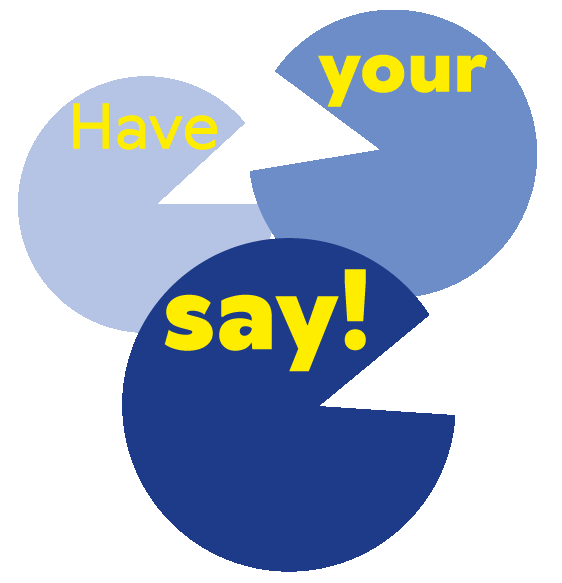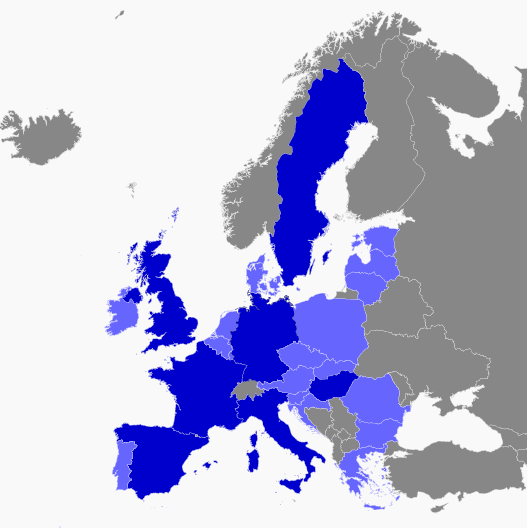Educational games about the EU developed and tested in the Have Your Say project 2019-2022
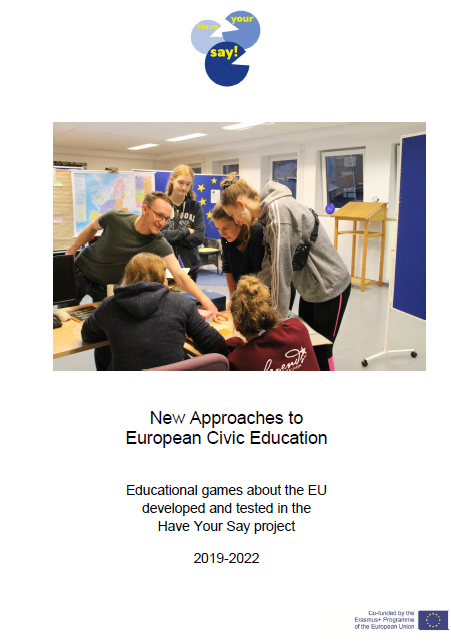
Introduction
This book presents eight educational games, developed by eight adult education and civil society organisations in 2020-2022. The games are intended to help those who play them develop their understanding of the European Union (EU), its nature, its purpose, and the question whether it is good to have such an organisation, or not.
The EU is a notoriously difficult topic. It is complicated, with structure and decision-making procedures that seem intransparent to many people. EU institutions seem to be far away of people’s everyday life, and people who barely understand who decisions are made in their own local city council have hardly are all the more challenged when facing the EU. And although it could be easy to define the EU simply as “a club of countries who that way
coordinate their laws and policies”, people usually are not aware of it, not least because the EU’s image can not (yet) rely on a popular and comprehensive narrative to justify its existence - a narrative that national states have been using for nearly 200 years now to make themselves seem “natural” entities.
So, teaching about the EU is a challenge. Most people are not naturally interested in understanding the EU. This is true not least for people at the lower end of formal education.
As you will see in the short presentation of the Have Your Say project (see below), the starting point of this project was the abundance of myths and false claims about the EU that circulated all over the public when “Brexit” – the idea that the UK should revoke its membership in the EU – was on the agenda in 2016 ff.
We, a number of adult education organisations from various European countries, started to contemplate what we ourselves could do to fight such misinformation, and the readiness of people to uncritically devour it. Aware that the EU is a very “dry” topic for most people, we came to the conclusion that it would be useful indeed to have tools at hand to offer people occasions to learn about the EU in ways as joyful and engaging as possible.
When applying for an Erasmus+ strategic partnership grant for this, we yet let it open what kind of educational activities these should be. We thought of seminars, drama, workshops, public actions, happenings… It became, however, relatively quickly clear that the most practical thing to do would be to develop games.
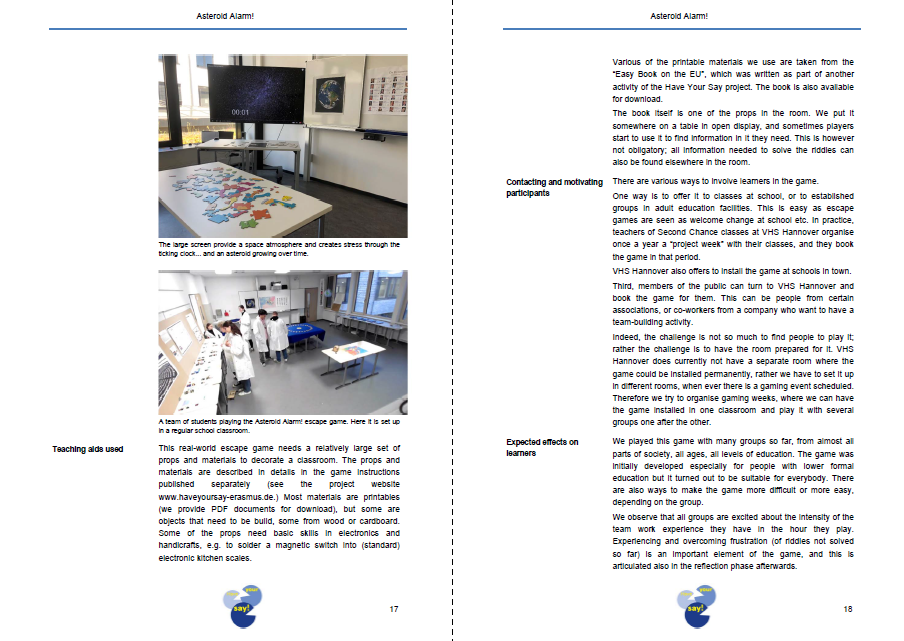
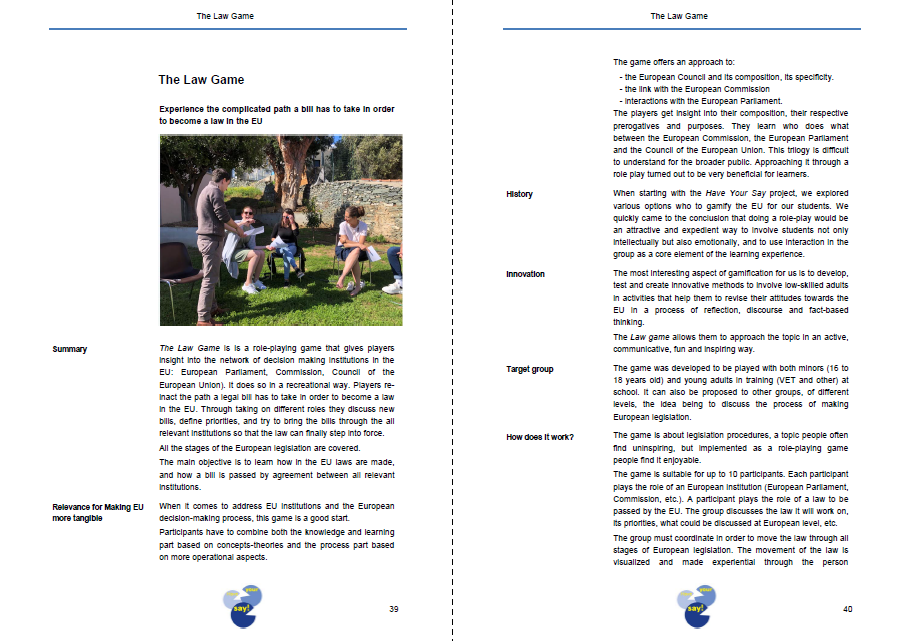
Download
[...]
This book presents reports about learning environments created by organisations in 7 European countries for helping people – particularly adults – improve their understanding of politics, the way how decisions are made in a democracy, and last but not least the idea and functioning of the European Union.
The collection reflects the state of the art in about 2019 or early 2020. That’s when our “Have Your Say” project started. In this project we wanted to create low-level learning opportunities for adults that would help them develop a better understanding of the EU, possibly facts-based rather than myths-based, but leaving it open to them to draw their own conclusion whether the EU is a good or bad idea.
This book is the result of our first activity in the project: looking around to see what others had done that would help us in our task. “Others”, this means: other organisations involved in educational activities, particularly with adults. “We”, that’s staff of 8 providers of adult education from seven European countries: Germany, Italy, Spain, Hungary, France, Sweden, and – interestingly – the United Kingdom which had just recently taken the decision to leave the EU, and did so during the three years implementation period of our project.
The task for the teams in all 7 countries was to identify a number of games, workshops, seminar concepts, scenario games and so on that would match our intention and could serve as interesting examples to learn from. In a co-operative process of discussions and assessments, we identified then 3-4 per country (twice as much for Germany) that seemed most interesting to us.
In this book we present the 24 approaches selected.
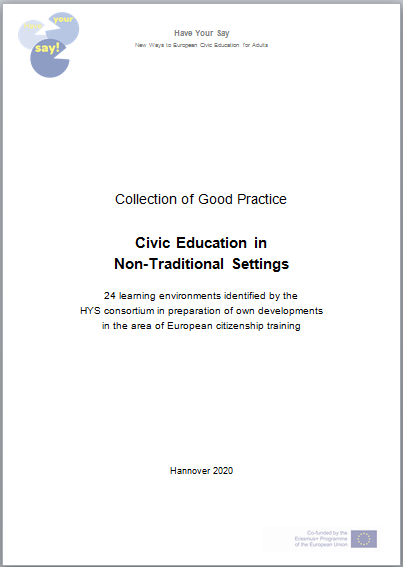
Contents
These are the examples covered (and page numbers in the book)
Where is Mika? - Escape room - P. 14
In the Where is Mika escape room, players have the task to find a disappeared girl, Mika. They have to rummage through the belongings she left in her room when she disappeared, and the task is to draw the right conclusions in order to eventually find out where she has gone. As all educational escape rooms, Where is Mika helps players develop their cognitive and social skills, not least through practicing team work.
Fortress Europe - Simulation game - P. 19
This simulation game is very much in the centre of the idea oft he HYS project: to lead learners (or who ever participates) into a process of getting to know the Europan Union as an institution, and start to form their own position about it, possibly as a side-effect of pleasant activities in cooperation with others. The downside of this example is that it requires relatively high-skilled students
Legislativity - Board Game - P. 25
A typical board game, with a cardboard playground and various utensils such as meeples, dice, and cards introducing various surprising events or circumstances into the game. Can be played by up to 8 players, or more when they form teams. Each team tries to move their bills (proposals for new laws) through the EU legislation procedure. The learning objective of the game is to get familiar with the EU legislation procedure.
Pimp your town. - Simulation game - P. 29
In the simulation game Pimp Your Town! students get to know the processes in municipal politics in an action-oriented and sustainable manner, they can also bring their own ideas into local politics.
Pimp my science - Simulation game - P. 33
The science game “Pimp my Science” was developed based on the simulation game Pimp your Town (see above). Pupils work with experts, write proposals on the topic of science and discuss them, supported by politicians. This creates a public dialogue about diverse aspects of science.
Immigropoly - Online game - P. 37
An online game exploring the subject of migration, which incorporates an educational element developed by the ID Research workshop, PĂ©cs, Hungary. The game provides for a unique experience in addressing issues of immigration and integration. It is available in Hungarian and in English.
Migrantas - Arts & design workshop - P. 41
Migrantas is an initiative of artists and designers in Berlin. They use visual arts and graphic design in workshops for other migrants (mostly women), helping them to create drawings reflecting their life journey. The drawings are then condensed into pictograms and distributed in public spaces.
Sociopoly - Board game - P. 45
Sociopoly presents gamers with a small town in northern Hungary. Players are put into the roles of various people in the village, belonging to different classes, and let's the live through four weeks of village live, while having to make to with the resources and obligations their roles are provided with.
Europa=noi - Online learning environment - P. 49
Europa=noi is a large online learning environment about the European Union. It offers a journey to discover European history, values, institutions and programmess, with a focus on the rights and duties associated with citizenship and the European treaties. Available for Italian-speaking users.
Essereuropei - Series of events in a city - P. 53
Essereuropei (“To be Europeans”) was a sequenze of educational events organised by the municipality of San Lazzaro di Savena (Bologna) in autum 2019. It involved 150 students over a period of 4 months, and made them participate in workshops, a photo contents, video production, etc.
Learning Legality - Series of events - P. 57
The social cooperative Lai Momo in Bologna organized a series of educational events for Asylum seekers. Especially interesting (from the perspective of European citizenship awareness) were meetings with police officers and legal experts to make newcomers to the country familiar with the legal system, especially regarding labour law and interpersonal relationships. Different groups of asylum seekers took different lessons from it, mostly depending on their country of origin.
Community Art - Arts and self confidence - P. 63
Adult students with little formal education go through a process of creating works of art to gain confidence. They do this in parallel with children from primary school. - At first glance it may seem that this activity is little related to European citizenship training, but CEPA San CristĂłbal, through its various life-history related activities showed us that citizenship (European or other) needs self-aware and self-confident citizens, and offering low-skilled adult learners opportunities like this helps them gain confidence and awareness.
Getting to Europe friends - Classroom activity - P. 68
Getting Europe friends is a classroom activity developed by CEPA San Cristóbal adult education centre in Tenerife. A group of students – young adults with very low formal education – is encouraged to collect basic information about a number of European countries (chiefly via online research), to structure this information, and eventually to produce video clips to present these countries to their classmates.
Who is who, and why do you think so? - Classroom activity - P. 73
Using a multimedia application programmed for the purpose (available via internet), students are shown photographs of various people, both unknown ordinary persons and celebrities. They are asked to associate with these photographs various characteristics of personality, and professions or occupations. This is then used to start a discussion about prejudices, to start self-reflection, and to become aware of traces of racism,. and of questions of societal integration. The relation to European citizenship training is again on the level of building up awareness, including awareness for (and appreciation of) diversity.
Human Rights in Practice. 78
Board game to help newly arrived immigrants become aware of human rights. The game consists of seven sections with different themes that all relate to Swedish society. These themes are developed to help newly arrived immigrants to orient in their new home country. Themes that are being discussed are for example family, health and education.
No Alternative Facts. 84
Online learning platform created as part of an Erasmus+ project by partners from several countries, offering various materials to learn about fake news, how they are created, and how they can be detected. Everybody can easily register and use the materials. The type of material is what e-learning platforms nowadays usually offer, with various tasks, activities, badges to earn, etc.
RĂĄdet (The Council) - Role game - P. 89
This role game is about democratic systems and political development. It uses a scenario of an all-inhabited galaxy, with many independent planets. Players are put into a role of representatives of these planets who, at a meeting, have to take common decision. The aim of the role-play is to encourage participants to act in a way that makes them take decisions in regards to what is best for their planet and coalition. This all, of course, invites to drawing parallels to the European Union.
Create your own propaganda - Classroom activity - P. 95
Stereotypes and propaganda are everywhere in society. Helping learners to notice them will help them to be careful with interpreting. This activity let’s learners in teams create their own “propaganda”, together with various arguments to distribute it and make it plausible to others. In this playful way, learners become aware of the phenomenon and start to become a bit more immune against propagandistic attacks.
Make your own slogan. - Classroom activity - P. 98
A classroom activity to make students aware of the power of slogans and the possibility to seduce people. After getting familiar with the notion of “slogan”, students select subjects for slogans to be created for, and then, in small teams, create slogans for them. With respect of European citizenship training this method can be interesting in order to raise awareness for the power of political slogans, especially when used by malignant actors.
Citizen Debate. 101
A classroom activity for training free speech and civilized debate in a save environment.
Ealing Mediation Service Training. 103
The West London Equality Centre offers trainings (of various length) to citizens who want to become mediators in their neighbourhood to help resolve conflicts. This can well be seen as a contribution to citizenship and building up a civilized society.
Legal Training for Everybody. 107
The West London Equality Centre offers workshops on a weekly basis where everybody interested in the legal system and the law can attend for free. Lecturers are practitioners of law, including solicitors, barristers, judges, and university professors. Thousands have participated in the trainings, and many have profited from it in their personal development.In the context of the Have Your Say project, the aspect of delivering legal training on a grassroots level is especially interesting, as knowing the laws and the legal system of a country is crucial for good citizenship.
The Street Mission’s coaching and training sessions. 110
Training offers for homeless in various public locations in London, combined with other forms of help, e.g. providing food and other necessary products as well as legal consultation.
Download
Collection of good practice (Pdf, 7 MB)
A good source for quick anc comprehensive information on the EU are the infographics published by the European Council. They cover a wide range of topics relevant for citizens.
Infographics an be found and downloaded at:
https://www.consilium.europa.eu/en/infographics/
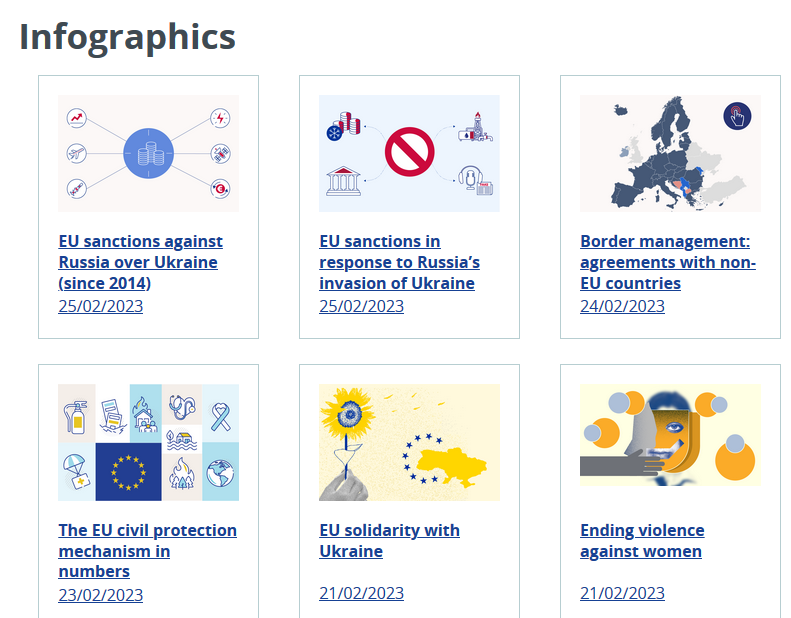 The EU offers infographics on crucial topics of the work done in the EU relevant for citizens. Screenshot of the website taken February 2023.
The EU offers infographics on crucial topics of the work done in the EU relevant for citizens. Screenshot of the website taken February 2023.
Below we list "Eleven Rules for Simple language" as published by Domingo de Oliveira, an accessibility consultant based in Bonn, Germany. He published this as a short practical guideline for the concept of Einfache Sprache [Simple Language], a form of expression approximately equivalent to language levels A2-B1.
Read more: Eleven rules for simple language (Einfache Sprache) - German
Books and brochures on the EU in easily accessible language – a brief review of publications found
One aim of the HYS project is to create a teaching aid on the EU that is easy-enough-to-read for people with limited command of the language (approximately level A2-B1). Here is a collection of already existing similar products which we use as a point to start.
Here we collect ressources on the topic of accessible writing in variuos languages used in Europe.By "accessible writing" we mean forms of expression with reduced complexity, created especially for people with lower-than-full command of the language, especially in terms of reading.
Read more: Resources on accessible language in various countries
This is a (growing) collection of books, brochures and websites presenting the idea, history, and inner workings of the European Union as an assembly of nation states who that way try to homogenize their policies and legislation. Materials collected here are meant for the "normal" or "academic" reader; they are not meant for the reader in need of explicitly simple forms of expression.
Read more: Resources on how the EU actually works (in normal language)
The Easy Book about the EU is a teaching aid and textbook written in easy-to-read language, presenting the EU, why does it exist, what does it do, and how does it work. The book has been written as a teaching aid for all purposes, with special respect to those who are less trained in reading, and also those who are newcomers to a given language. Issued in 2022.
The book is available in several European languages: English, German, Hungarian, Italian, Swedish, Spanish and French.
See download links below.
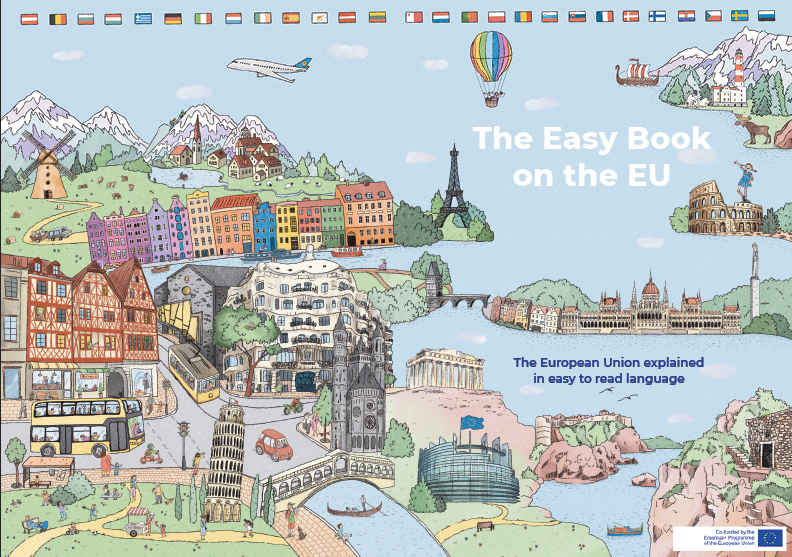 The book cover (back and front) presents a picture puzzle of EU countries' landmarks.
The book cover (back and front) presents a picture puzzle of EU countries' landmarks.
Introduction taken from the book:
What this book is about
In Europe, there is a very special community of countries. It is called the European Union, or short the EU.
The EU consists of 27 countries and the people of these countries. There are about 450 million people living in the European Union.
The countries have their independent governments.
Each country has its own rules and laws.
The laws that are created by each country’s government apply only to that country.
For example, the laws made in Germany only apply to people living in Germany. The laws issued in France apply only there and do not affect people in Spain, and the other way round.
The countries of the European Union have decided to take many decisions together und to unify their laws: one and the same rules should apply everywhere.
This has many advantages for all citizens, for example when they make holidays in another country, or when they buy and sell things across borders, or when they want to take a job in another country.
The European Union has been created in order to improve the lives of the citizens of its member countries. Not everybody always agrees with everything the European Union does. Still when critizing the European Union and what it does, it is best to know the facts.
This book has been written to give you an easy-to-understand source of information about what is the European Union, how it works and what it does.
This book gives information about
- The history of the EU
- What the EU does
- Important institutions in the EU
- Benefits and disadvantages of the EU
You can read the book from cover to cover. You can also start reading where there is something particularly interesting for you.
Happy reading!
Want to read this introduction in Hungarian? Here you are!
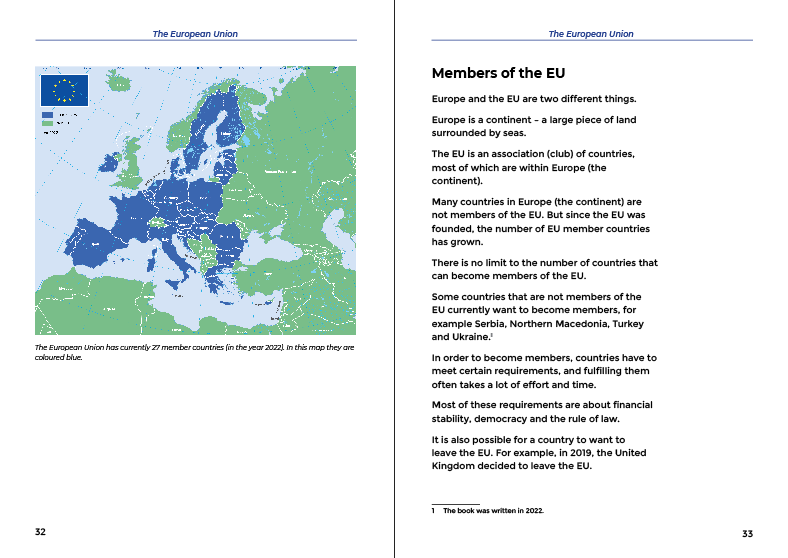 Pages from the book: chapter on how to become EU member state.
Pages from the book: chapter on how to become EU member state.
Download your copy of the book
This copies are in spread-view with 150 px resolution of pictures, chiefly meant for screen use.
We will provide high-resolution files (single page) for print later.
Hungarian edition (30 MB) - (Updated 2023-06-12)
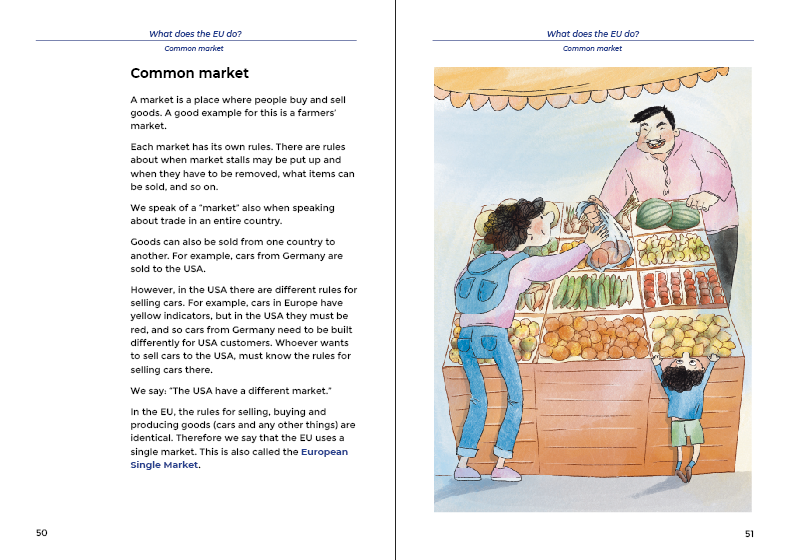 Pages from the book: chapter about the common market.
Pages from the book: chapter about the common market.
Chapter taken from the book:
Notes to the teacher
This book has been written to give information about the European Union (EU) – its history, its foundations, its values, its institutions, the way of its law-making, and generally what the EU means for the citizens of its member countries.
Who can benefit from reading this book?
We have written this book in very simple language so that it can be used by everybody including individuals with lesser command of the language. These can be people who are new to the country and the language, or people who have been facing obstacles at school.
Still we assume that the reader is interested in understanding some basic facts about the European Union.
This Book can be used by teachers in delivering seminars, lectures and tasks to their students. It can also be used by individuals to improve their familarity with the idea of the European Union, and key concepts and terminology to it.
The book may be used also a quick reference for looking up certain facts about the European Union, when in doubt.
For example, we use it in an educational Escape Room – a fun activity for everybody to learn something about the EU without even recognizing that there is an educational purpose – as an optional source for people to find out facts about the EU as they need it in the game.
The book is published in English, German, Spanish, French, Italian, Hungarian and Swedish.
Why do we think this book is useful?
The idea of the European Union has often been described as an idea that is difficult to grasp and articulate in a simple manner. This is necessarily so, as the European Union is a very complex thing. Also, from the perspective of most citizens, the EU’s institutions are mostly in foreign countries, people working in the EU usually use English or French as working language, and the procedures how the EU takes decisions and influences our everyday life are complicated. Hence the EU is a very abstract entity. People in their everyday life do often not see where the EU plays a role for them, or how they can play a role in the EU.
Moreover, there are a lot of false impressions about the EU out there, and in recent years false information about the EU has been distributed on porpuse by political actors who want to destroy the EU, or at least want to reduce its role in international or national politics and economy.
False information about the EU is an obstacle for citizens to take good decisions in elections. There is a lot of good information about the EU available in academic or other high-level language. What we found lacking is information on the EU accessible to really everybody.
Therefore, we saw the need of a source of information that gives reliable information on the EU in a language as easy to understand as possible.
Language used in this book
For the language used in this book we tried to follow principles of so-called plain language. Other terms are in use are easy language, simple language, et cetera. With respect to this book being issued in 7 European languages in parallel, we could not stick to one established model plain language. Concepts of plain language very much differ between national contexts. In some countries they are widely used (with the purpose to be inclusive). In other countries the idea has just begun sprouting. Hence what we did is, we tried to derive common rules from those plain language concepts we found available for various languages when we started working on the book in 2019/2020.
The process of writing this book
This book is one of the outcomes of the Have Your Say project – a three years co-operation of eight adult education organisations from seven European countries. The project was funded in 2019-2022 through the Erasmus+ programme of the European Union (as a “Strategic Partnership in Adult Education”). The project set out to develop new approaches to learning about the EU that should be both facts-oriented and entertaining. The book was to serve as a teaching aid to support the games and other learning activities. The book would give learners a source of information on the EU that is factually correct but easy to read.
For the contents of the book we took particular inspiration by a brochure published by Bundeszentrale fĂĽr politische Bildung (BPB, German Federal Center for Civic Education) in 2018 on occasion of the European Elections taking place that year.* The brochure was intended especially for readers with learning disabilities. It therefore uses highly simplified language along the principles of what is known, in German speaking countries, as Leichte Sprache. In practice we had found this brochure useful also for other audiences, e.g. for students in Second Chance classes where young adults can get a school-leaving certificate.
Starting from this model, after creating a first translation into English, we re-arranged and updated the contents according to the needs of our target public, and added topics we found missing. Various other publications on the EU issued by various organisations in various countries were also taken into consideration . The editing and authoring was done in English, the working language of the partnership, with contributions made by all partners. The final touch on the English text was provided by Joseph Karauli (West London Equality Council) and Christian Geiselmann (Volkshochschule Hannover). Partners then created the local language versions of this book based on the English.
Illustrations for this book were made by Kseniya Kochkina. She also drew the panorama picture for the cover pages.
-------
* Einfach Politik. Europa. Heft in einfacher Sprache. Available from BPB, www.bpb.de/shop, order number 9366. ISBN 978-3-8389-7176-6
Here you find a list of rules to follow for producing texts in the Easy-to-read variety of expression in English.
Read more: Easy-to-read in the UK: a set of rules to write extremely simply
Page 1 of 3

